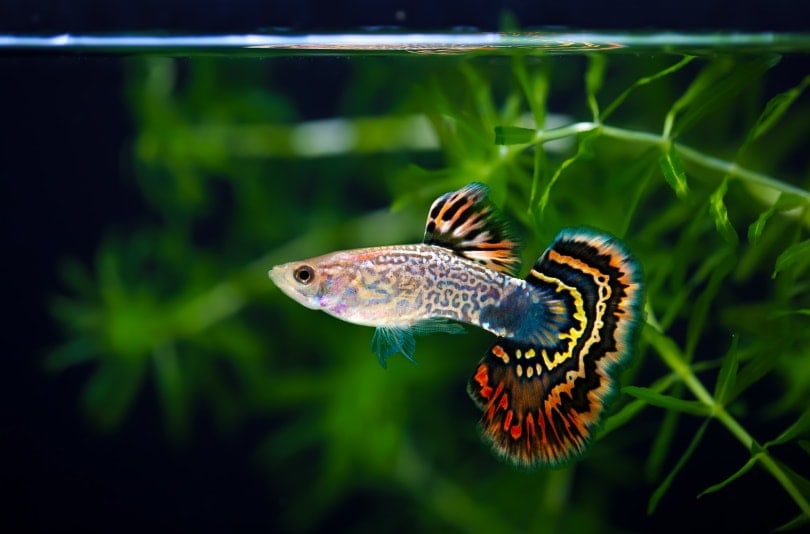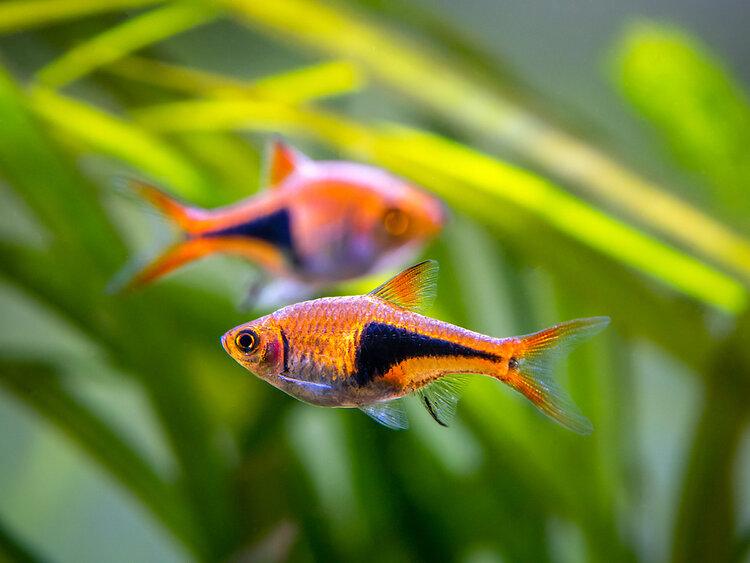Is Lucky Bamboo in Aquariums Safe for Fish? Benefits & How to Grow It

Updated on
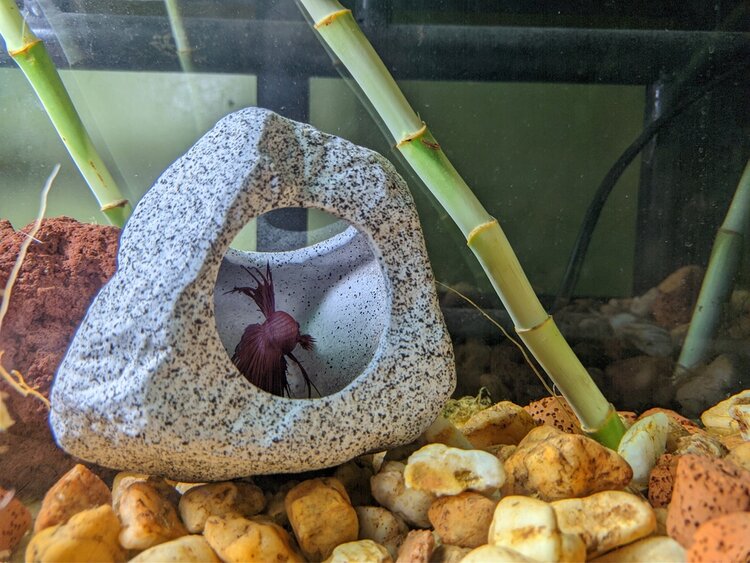
The stalky bamboo shoots commonly seen in vase-shaped aquaria make a great aquatic plant for aquariums. It is safe for fish and invertebrates and does not fall under a form of a true aquatic plant. They are great for producing oxygen within the aquarium and do well when partially submerged. Due to its length, lucky bamboo is easy to submerge with the top part of the bamboo stalks sticking out. This can look incredibly attractive and exquisite inside of a natural, planted aquarium.
BUT! you cannot put normal bamboo in your fish tank as the roots, and the plant as a whole will immediately begin to rot. However, lucky bamboo can be put in a fish tank at your own risk. Lucky bamboo can help with keeping the water parameters under control. If you keep an overstocked aquarium and the nitrates within the water fluctuate frequently, lucky bamboo will readily absorb the nitrates and use them for growth. This article will examine how to successfully grow lucky bamboo in your aquarium and the reasons it is a safe plant for your tank’s inhabitants.
What Is Lucky Bamboo?
Lucky bamboo (Dracaena sanderiana) is a common household plant that is commonly kept in tall vases as a household decoration. It is easy to care for and does not require soil to grow in. It does well half-submerged and is hardy enough to survive in a small amount of water. Aside from lucky bamboo not being a true aquarium plant, it is not even a species of bamboo.
Lucky bamboo can produce twirling or straight stems with sparse vibrant green leaves growing out of the sides. It does not get as large as true bamboo and remains a vivid green color. You may notice a pattern of light brown rings every few inches along the stalk of the plant.
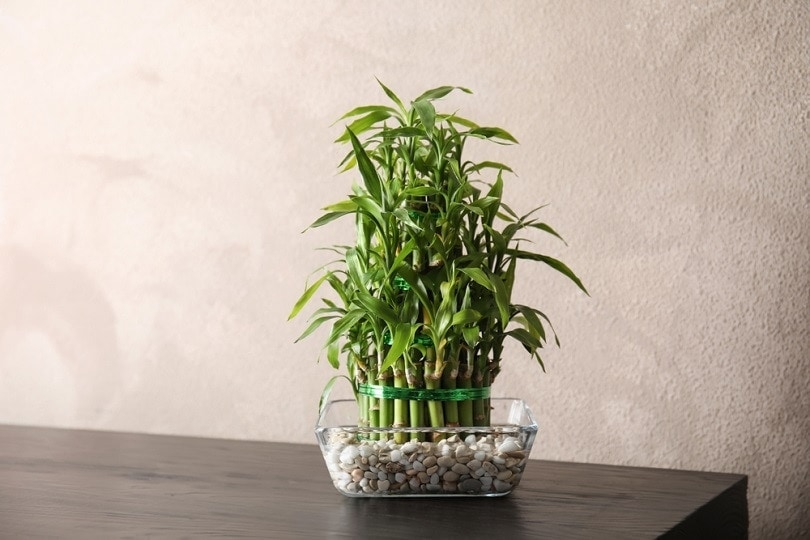
The Difference Between True and Lucky Bamboo
- True bamboo: It is related to the grass family and is a close relative to the grass that is growing in your yard. True bamboo is also closely related to plants that produce popular foods like rice, wheat, and barley. There are approximately 1,000 species of bamboo around the world. True bamboo is invasive in the wild and can grow to great lengths in a group-like formation. They grow larger, thicker, and take on a slightly different color than the lucky bamboo.
- Lucky bamboo: This plant is native to Cameroon in Central Africa. It is a type of flowering lily and is not related to grass or common edible plants. Lucky bamboo grows under canopies in tropical forests and can survive droughts and temporary flood conditions. Lucky bamboo is exceptionally flexible when it comes to caring for them. The plant is hardy and suitable for those who struggle to grow other plants. Lucky bamboo will be able to survive your novice mistakes.
How to Successfully Grow Lucky Bamboo in an Aquarium
Lucky bamboo does well in different shapes and sizes of aquaria. You can easily introduce lucky bamboo into your aquarium with minimal effort or changes within your aquarium.
1. Ideal water requirements
Lucky bamboo should be kept in freshwater aquariums and will die off if kept in brackish or saltwater aquariums. The pH of the water should ideally be acidic and between 6.0 to 7.5. Water hardness does not affect lucky bamboo too much, and it should only be placed in an aquarium that has been treated with a dechlorinate.
Chlorine can cause root stress and eventually kill off your lucky bamboo plant. The once vividly green leaves can turn yellow and fall off. All species of captive inhabitants like fish, snails, or shrimps, as well as other aquarium plants, should only be in dechlorinated water.
You should avoid using water that has high amounts of fluoride as it is toxic for lucky bamboo. If you have fluoridated water, you can use bottled and filtered water instead. Just make sure it is ideal for the inhabitants.
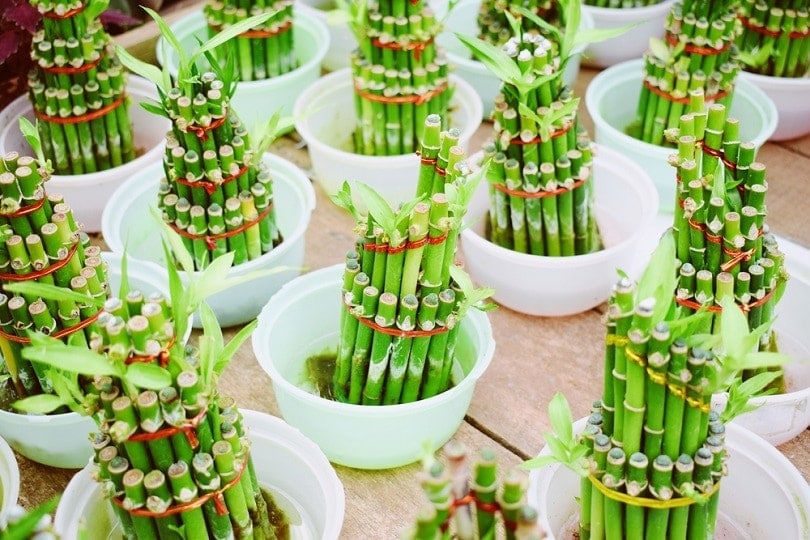
2. The substrate and water depth within the aquarium
Lucky bamboo can survive if its roots are submerged. You can keep lucky bamboo in or without a substrate, and it will still thrive. The top stalks can be exposed to air and stick out of the aquarium without it affecting their growth. The roots should be submerged in at least 2 to 4 inches of water, and efforts should be taken to keep them covered in water to avoid the roots from drying out.
If you have substrate inside of the tank, you can plant them at least 4 inches deep within the substrate. Pebbles or gravel are great options for a substrate that allows a decent amount of water circulation to reach the roots.
Aquarium sand is not the best option as a substrate because it does not allow the necessary amount of water required to support their growth and health. If the substrate is depriving the roots of proper water circulation, the roots will develop hypoxia with dead zones. It is best to avoid drying out the roots because the roots will burn when exposed to air for a long period.
3. Lucky Bamboo Lighting Requirements
Lucky bamboo appreciates moderate lighting and does not require artificial growth lights or even bright window lights. They need at least 6 hours of light to complete photosynthesis. Bright lights will cause the leaves to burn, which is seen by the decaying yellow or browning of the leaves.

4. Fertilization and Carbon Dioxide Requirements
You can use liquid fertilizers or even root fertilizer tabs in the gravel or pebbles that the lucky bamboo is buried in. They do not, however, require fertilizers and grow well using only the aquarium water’s nutrients. Fish produce enough waste to supply your lucky bamboo plant with a variety of nutrients to support its health and growth.
The carbon dioxide your fish creates within the water is enough to keep your lucky bamboo plant growing healthy. CO2 diffusers are potentially dangerous and unnecessary to use for your fish or invertebrates.
The 4 Myths of Lucky Bamboo Dangers Within the Aquarium
- Lucky bamboo releases toxins into the water: This is false because the lucky bamboo plant is unable to release any toxins. This myth stemmed from the potential ammonia spike the plant can cause within the aquarium, which is unrelated to the plant’s components.
- The leaves must grow above the water: This is simply untrue, and you can submerge the leaves with no problems. The plant can handle being both fully and partially submerged in the aquarium for a couple of years.
- The plant will entrap your inhabitants: This is partially untrue. You should aim to keep lucky bamboo in a formation that has a decent amount of space between the stalks for your inhabitants to swim through. If you keep your stalks tightly packed, some fish can get stuck between the talks. This is common with goldfish.
- Toxic when consumed: This is false. Most inhabitants will not find an interest in the texture and taste of the plant, but it is not harmful to them if they consume a part of the plant.
Growth Rate and Benefits of Lucky Bamboo
Lucky bamboo grows moderately slowly and grows faster if it is planted into a substrate. The plant can grow for a few years to maximize its size if it is kept in good condition. If your lucky bamboo plant receives more light, the plant will grow at a faster rate.
A welcoming benefit of lucky bamboo is that it helps to increase the overall oxygen in the water. This helps the other plants and provides the inhabitants with more oxygenated water.
Conclusion
Lucky bamboo looks great when kept with smaller fish, snails, or shrimps. This easy-growing species can make a great addition to your aquarium while being completely safe for the inhabitants. It makes a great plant for first-time plant aquarists. We hope this article has helped you understand lucky bamboo’s appropriate care and the safety of your aquarium’s inhabitants.
Related Read:
- Where Do Aquarium Fish Actually Come From? The Surprising Answer!
- 21 Most Colorful Freshwater Aquarium Fish (with Pictures)
Featured Image Credit: Gonzal de Miceu, Shutterstock



